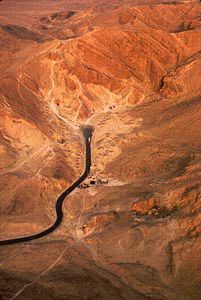
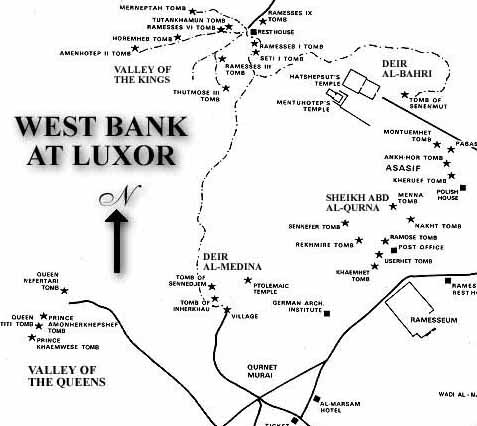
The Valley of the Queens, also known as Biban el-Harim, Biban el-Sultanat, and Wadi el-Melikat, is a place in Egypt where wives of Pharaohs were buried in ancient times. In ancient times, it was known as Ta-Set-Neferu, meaning - 'the place of the Children of the Pharaoh', because along with the Queens of the 18th, 19th and 20th dynasties (15501070 BCE) many princes and princesses were also buried with various members of the nobility. The tombs of these individuals were maintained by mortuary priests whom performed daily rituals and provided offerings and prayers for the deceased nobility.
The valley is located near the better known Valley of the Kings on the west bank of the Nile across from Thebes (modern Luxor) . This barren area in the western hills was chosen due to its relative isolation and proximity to the capital.
The kings of the 18th dynasty, instead of the traditional building of pyramids as burial chambers (perhaps because of their vulnerability to tomb robbers), now chose to be buried in rock-cut tombs.
This necropolis is said to hold more than seventy tombs, many of which are stylish and lavishly decorated. An example of this is the resting place carved out of the rock for Queen Nefertari (1290-1224 BCE) of the 19th Dynasty. The polychrome reliefs in her tomb are still in tact.
The ancient Egyptians gave it the name Set Neferu, meaning "seat of beauty". From 1903-1906 an Italian expedition discovered about eighty tombs, some of which belonged to children of royalty. Many were severely damaged having been burned and or reduced to being used as stables for donkeys and camels. One of the most well-known tombs is that of Nefertari, the best-loved of Ramesses II's numerous wives. In her honor he built a beautiful temple at Abu Simbel.
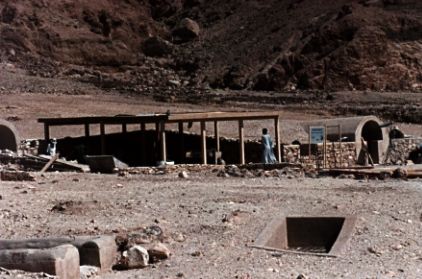
Nefertari (Nefertari Merytmut) c. (1300-1250 BC) was the Great Royal Wife (or principal wife) of Ramesses the Great. She is one of the best known Egyptian queens, next to Cleopatra, Nefertiti and Hatshepsut. Her lavishly decorated tomb, QV66, is the largest and most spectacular in the Valley of the Queens.
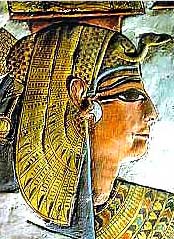
Queen of Rameses II (19th Dynasty, 1279-1213 BCE).
The brilliant colors and draftsmanship of its painted reliefs
make it one of Egypt's most outstanding tombs.
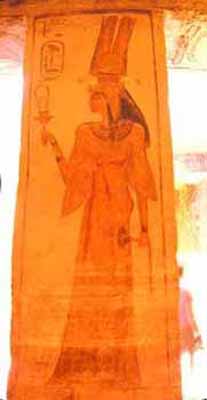
Nefertari - Photo taken in her Abu Simbel temple
The Valley of the Queens is the site of over 90 tombs of royal wives, sons, and daughters from the 18th, 19th, and 20th Dynasties. (Royal women of the 18th Dynasty appear not to have had one exclusive cemetery but were buried in many, often remote locations, as well as occasionally in the Valley of the Kings) Early tombs lie at the northern 'mouth' of the valley, later tombs nearer its southern end.
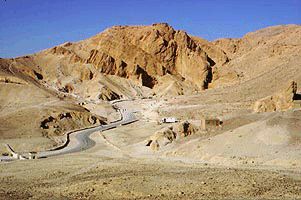
Other tombs include:
The Tomb of Khaemwese (Tomb 44): Scenes in Khaemwese's tomb show him being presented to the guardians of the gates to the afterlife along with his father. He is making an offering in the scene, and is dressed in a robe, wearing a necklace and the sidelocks of youth.
The Tomb of Queent Titi (Tomb 52): She is probably the queen of a 20th Dynasty. She is depicted with the sidelocks common to the Egyptian young of the period and in the presence of the gods Thoth, Atum, Isis and Nephthys. In the next chamber the queen is shown making offerings to Hator the cow, and in the last chamber the gods Neith, Osiris, Selquit, Nephthys and Thoth.
The Tomb of Amenhikhopeshef (Tomb 55): Amenhikhopeshef was a son of Ramses III and scenses show him with his father and the gods Thoth, Ptah and others. He was probably about nine years old when he died. Scenes show him being presented to various gods, including Anubis, the Jackal-headed god of the dead, by his father, Ramses III. A premature baby was also found in to tomb. This belonged to this mother, who aborted upon learning of Amenhikhopeshef's death.
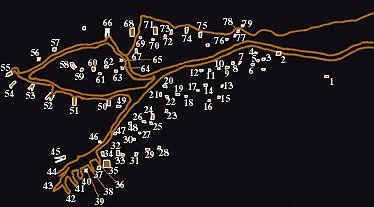
Tomb no. 30 - Nebiri (probably), Head of the Stable, Dynasty XVIII
Tomb no. 31 - A Queen
Tomb no. 33 - Princess Tanezem(t) Dynasty XX (?)
Tomb no. 36 - Princess, no name
Tomb no. 38 - Queen Sitre' wife of Ramesses I
Tomb no. 40 - A Queen, cartouche blank
Tomb no. 42 - Prince Para'hirwenemef, Charioteer of the stable of the Great House, son of Ramesses III
Tomb no. 43 - Prince Set-hirkhopshef, King's son, Hereditary prince of the royal children of his Majesty, Charioteer of the Great Stable. Son of Ramesses III.
Tomb no.44 - Prince Kha'emweset, Sem- priest of Ptah. Son of Ramesses III.
Tomb no. 46 - Imhotep (probably) Vizier. Tuthmosis I.
Tomb no.47 - Princess 'Ahmosi Daughter of Sekenenre'-Ta'a and Sit-dhout:
Tomb no.51 - Queen Esi II mother of Ramesses VI, daughter of Hubalznet:
Tomb no. 52- Queen Tyti Ramesside
Tomb no. 53 - Prince Ramesses son of Ramesses III
Tomb no. 55 - Prince Amen(hir)khopshef Royal Scribe, Overseer of Horses, son of Ramesses III
Tomb no. 60 - Queen Nebttaui daughter of Ramesses II
Tomb no. 66 - Queen Nefertari Wife of Ramesses II
Tomb no.68 - Queen Merytamun daughter of Ramesses II
Tomb no.71 - Queen Bent'anta daughter of Ramesses II
Tomb no.73 - A Princess, no name. Dynasty XX
Tomb no.74 - Queen Tentopet Great King's mother and King's wife
Tomb no.75 - A Queen, no name
Unnumbered Tombs and Pits
Queen Mut. . . perhaps Tuy (Mut-tuy), wife of Seti I, mother of Ramesses II. West of Tomb 66.
'Ahmosi King's son, son of Nebsu and Ian
A hundred metres east of Tomb 47 in a small valley. Dynasty XVII
Princess Neferhet King's daughter, New Kingdom. Probably south-east of Tomb 75
Tombs in Branch valley, south-west of the Valley of the Queens
Remains of canopic-jars, including one with text of a queen, Dyn XXV or XXVI (from excavation in 1895).
Tomb of Princess - from time of Amenhotep III. Position unknown.




0 comments:
Post a Comment